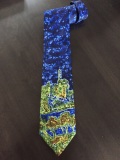- Ties (Neckwear)
- >
- Citadel of David Silk Tie
SKU:
Citadel of David Silk Tie
$36.00
$25.00
$25.00
On Sale
Unavailable
per item
“Also he (King Hezekia) strengthened himself, and built up all the wall that was broken, and raised it up to the towers and repaired Millo in the city of David and made darts and shields in abundance” (Chronicles II 32:5)
The tie features a scene depicting the tower from a westerly view. The scene below the tower is of a grove of olive trees of some which are hundreds of years old. This impressionistic illustration helps portray the tower as a Jerusalem Icon through time. The Tower of David dominates the old city from its highest point.
Since the second century BCE the fortress has guarded Jerusalem vulnerable northern and western approaches. Each successive ruler of the city, aware of the site’s importance, buttressed and rebuilt it, endeavoring to out do his predecessors The victory of Judah the Macabee over the successors of Alexander the Great marked the start of the Hasmonean dynasty in the second century BCE. It was a period of prosperity, reflected in large-scale construction in Jerusalem, the Kingdoms capital. The earliest structures built of impressive hewn stone, are the remnants of a wall and two towers, which probably define the city’s western limits in the Hasmonean period. On the ground of the Citadel were hundreds of arrowheads along with catapult and sling stones perhaps from the siege laid on the city in 132 CE by Antiochus IV. No one built Jerusalem more grandly than King Herod, about 150 years later. The majesty of the Western Wall is evidence of his prowess as a builder of monumental structures. His major contribution to the city’s fortifications consisted of the three magnificent towers of the Citadel, named after his brother, good friend and his wife: Phasael, Hippicus and Miriam. When Rome gave way to Byzantium, Jerusalem became a magnet for Christian pilgrims. In this period the Citadel was probably not used exclusively for military purposes; small enclosures with rough mosaic floors suggest monks, quarters. But the Byzantines, too, reinforced the Citadels walls, using the ancient stones dislodged in previous battles. In 638 CE the Arabs overran the city, ruling for the next 460 years. They built a smaller Citadel with a rounded tower, the ruins of which are still visible in the southern part of the inner courtyard.




